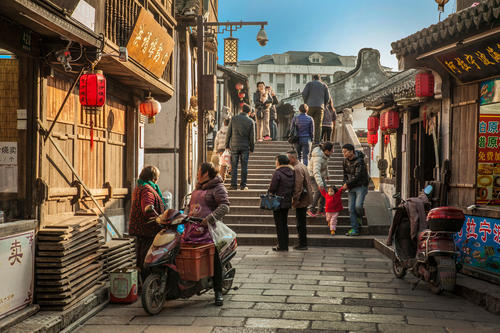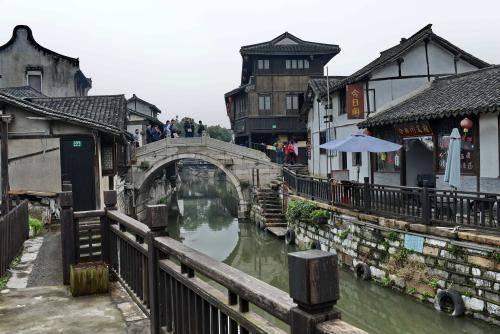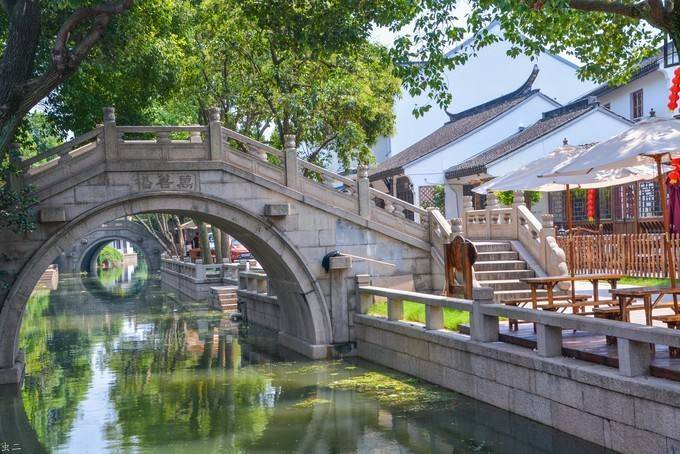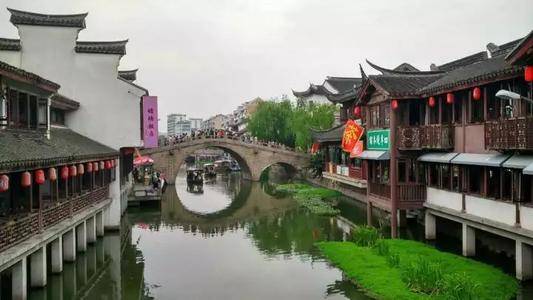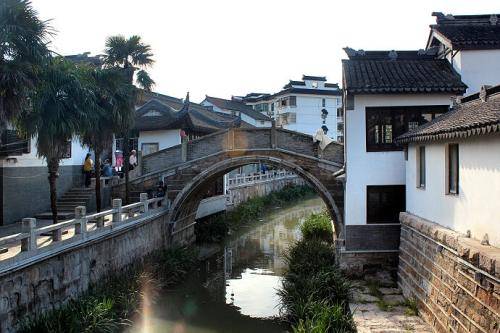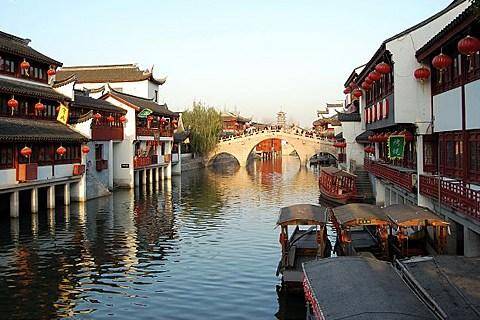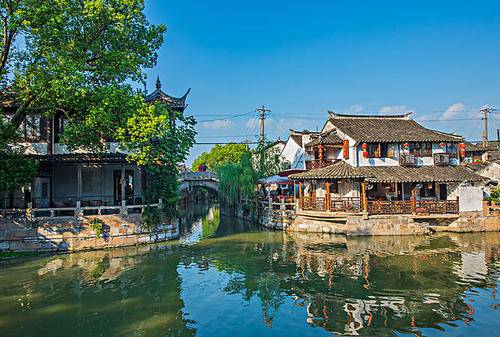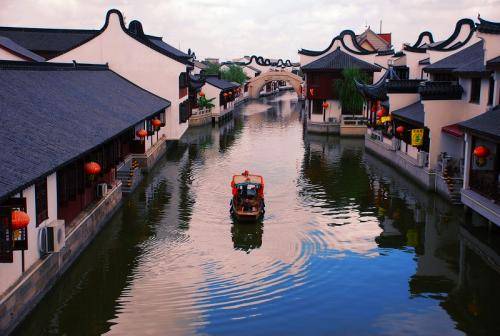Known as 'Little Xinchang surpasses Suzhou', it has a history of over 800 years. The formation of a new salt field due to the southward migration of the Xiasha Salt Field gave it the name 'Xinchang'. Xinchang Ancient Town currently preserves 150,000 square meters of contiguous ancient buildings, with over 100 ancient residential houses, mostly four-entry courtyards with hanging eaves, carved beams, and painted rafters. The ancient alleys of the Ming and Qing dynasties are all family courtyards of various surnames. Admission: Free.
Zhujiajiao Town
This is one of the early and better-preserved ancient towns in Shanghai. Known as the 'Venice of Shanghai', 'Hollywood of Shanghai Suburbs', and 'South Zhouzhuang, North Zhouzhuang, not as good as a corner of Zhujiajiao'... these are the accolades of the ancient town. The old streets of Zhujiajiao are full of ancient charm, with winding alleys that lead to secluded spots, mysterious and quaint, both bustling and tranquil. The bustling areas have shops along the streets and residences upstairs. Shops are lined up one after another, and the place is lively and bustling all day long! Admission: Free.
Legend has it that during the Three Kingdoms period, the Eastern Wu built ponds here to train their navy, hence the name 'Liantang'. 'Tall houses, narrow alleys facing the street, small bridges and flowing water by the homes' is the unique scenery of Liantang. Most people here love listening to Pingtan, and there is a Pingtan Art Museum in the town that introduces a lot of knowledge about Pingtan. Interested friends can visit here for free. Ticket: Free.
"The largest town in Pudong", it is very tranquil. Although it has a history of 450 years, it remains a rare peaceful place in the bustling city. The ancient city wall built to resist the invasion of Japanese pirates, the Yuebei Pavilion engraved with Yue Fei's handwriting, the Kuixing Pavilion of the old Wenchang Palace, and the ancient fort relics from the Anti-Japanese War are all memorials left by Chuansha's history. Strolling through the nostalgic streets of Chuansha, you can feel the past emanating from the stone-patterned wooden windows, the white walls and gray tiles narrating history, and the blue bricks and small stones flowing with serene time. Admission: Free.
Located in Baoshan District, Shanghai, it has a history of more than 700 years. It was a major commercial town during the Ming and Qing dynasties, known as the 'Golden Luodian'. The town features riverbanks, ancient stone arch bridges, long streets with old shops, and exudes the graceful charm of the Jiangnan water town. The most famous is the street-river layout of 'Three Bays, Nine Streets, and Eighteen Alleys'. Admission: Free.
Qibao Town
It is often said that 'For a century-old Shanghai, look at the Bund; for a millennium-old Shanghai, look at Qibao.' The ancient town of Qibao has a long history, which is evident. It is also the closest ancient town to the city center, making it a bustling place filled with tourists. There is a folk saying that Qibao has 'seven treasures': the Flying Buddha, the Floating Bell, the Golden Lotus Sutra, the Sacred Tree, the Golden Rooster, the Jade Axe, and the Jade Chopsticks. When visiting Qibao, you might want to try finding these seven treasures. Admission: Free.
Sijing Ancient Town is also a thousand-year-old town, known as 'Hundred-year Shanghai, Thousand-year Sijing.' Unlike other famous ancient towns such as Zhujiajiao and Fengjing Town, Sijing Ancient Town seems to be somewhat unknown. However, when it comes to the culture of Sijing Ancient Town, it is truly a treasure trove. Anfang Tower, Fulian Bridge, Futianjing Temple, and the Former Residence of Ma Xiangbo are all sites with deep cultural and historical roots. 'Four Waters Converge' is one of the 24 scenic spots in Songjiang, with vast misty waters that resemble a fairyland. Admission: Free.
Nanxiang Old Street
Nanxiang Ancient Town is very famous. It is one of the four historical and cultural towns in Shanghai and was historically known as 'Little Nanxiang surpasses Suzhou'. It features typical Jiangnan water town scenery with small bridges, flowing water, and residential houses, showcasing the beauty of this Jiangnan garden water town. Nanxiang has twin pagodas, which are the oldest ancient pagodas in Shanghai and are precious treasures among ancient pagodas in China, with a history of many years. It is definitely worth a visit! Ticket: Free.
Fengjing Ancient Town is one of the new Eight Great Sights of Shanghai. Located at the intersection of Wu and Yue, it has long been known as a famous town of Wu and Yue. It is also a typical Jiangnan water town with a history of over 1,500 years. The town is crisscrossed with waterways, earning it the reputation of 'three steps, two bridges; a glance, ten ports.' Notably famous are the 'Three Bridges of Fengjing': Qingfeng Bridge, Zhuhang Bridge, and Beifeng Bridge, located at the intersection of Zhongda Street and Shengchan Road. These three bridges are closely connected, linking the scenic spots and local culture on both sides! Admission: Free (a combined ticket costing 50 yuan is required for visiting the exhibition halls).
This ancient town in Shanghai has been beautiful for over 800 years! 'Ten miles of morning mist broken, a few sounds of Zhaojia bell,' Zhaojialou is the earliest area in Shanghai to reclaim and cultivate land. The culture of Zhaojialou is the origin of Shanghai's farming culture. It has witnessed the legendary process of our ancestors, from diligently farming in ancient times to the rise of skyscrapers in modern Shanghai. One may forget the bumpy field ridges, but not the hard yet warm years. Visiting here during leisure time to experience the past is a wonderful thing! Ticket: Free.
